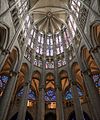Beauvais Cathedral facts for kids
Quick facts for kids Beauvais CathedralCathédrale Saint-Pierre de Beauvais |
|
|---|---|

Beauvais Cathedral from the south-east
|
|
| Religion | |
| Affiliation | Catholic Church |
| Province | Diocese of Beauvais, Noyon, and Senlis |
| Rite | Roman |
| Ecclesiastical or organizational status | Cathedral |
| Leadership | Jacques Benoit-Gonnin |
| Year consecrated | 1272 |
| Status | Active |
| Location | |
| Location | Beauvais, France |
| Architecture | |
| Architect(s) | Enguerrand Le Riche Martin Chambiges |
| Architectural type | Church |
| Architectural style | High Gothic |
| Groundbreaking | 1225 |
| Completed | Never completed. Works halted in 1600. |
| Specifications | |
| Length | 72.5 m (238 ft) |
| Width | 67.2 m (220 ft) |
| Width (nave) | 16 m (52 ft) |
| Height (max) | 47.5 m (156 ft) (height nave) |
|
Monument historique
|
|
| Official name: Cathédrale Notre-Dame | |
| 1840 | |
| PA00114502 | |
| Denomination | Église |
The Cathedral of Saint Peter of Beauvais (French: Cathédrale Saint-Pierre de Beauvais) is a huge Catholic church in the town of Beauvais, France. It is the main church for the Bishop of Beauvais, Noyon and Senlis.
This amazing building is built in the Gothic style. It has a very tall choir from the 13th century. This part includes an apse and seven small chapels that you can reach by walking around the main altar in an ambulatory. A large transept (the part that crosses the main body of the church) was added in the 16th century.
Beauvais Cathedral holds a world record! It has the highest Gothic choir in the world, reaching 48.5 metres (159 ft) (about 159 feet) high. For a short time, from 1569 to 1573, it was even the tallest building in the world with its tower of 153 m (502 ft) (502 feet). The people who designed it wanted it to be the biggest Gothic cathedral in France, even bigger than Amiens.
Sadly, the cathedral was never fully finished. It suffered two collapses, one in the 13th century and another in the 16th century. Because of this, only the choir and the transept were built. The part of the church called the nave, which is usually the long main hall, was never constructed. Instead, an older church from the 10th century, known as the Basse Œuvre, still stands where the nave was supposed to be.
Contents
History of Beauvais Cathedral
How Construction Began
Work on the cathedral started in 1225. This was after a series of fires damaged the old church that stood there. A bishop named Milo of Nanteuil helped fund the project with money from his family.
The choir, which is the area around the altar, was finished in 1272. The building work happened in two main stages. There was a break from 1232 to 1238 because of money problems. These problems were caused by a disagreement with King Louis IX. You can even see a slight change in the building's direction where the two stages meet.
Making it Taller
Under a bishop named Guillaume de Grez, the builders decided to make the cathedral even taller. They added an extra 4.9 meters (16 feet) to its height. This made it the highest-vaulted cathedral in Europe at the time.
The inside of the choir reaches 47.5 m (156 ft) (156 feet) high. This was much taller than Amiens Cathedral, which was being built at the same time and had a nave of 42-metre (138 ft) (138 feet). Beauvais Cathedral's choir is even a bit taller than the nave of St Peter's Basilica in Rome.
The First Collapse
Building work stopped in 1284 when some of the newly finished choir vaulting fell down. This event was a big setback for French Gothic builders. Some people thought it made them lose confidence in building such huge structures. The collapse also marked a time when smaller buildings were generally built. This was due to fewer people, the Hundred Years' War, and other challenges.
However, large Gothic designs continued. The choir was rebuilt to the same height. They added more columns to make it stronger. This changed the type of vaulting from four-part to six-part.
Later Additions and Another Collapse
The transept, the part that crosses the main body of the church, was built between 1500 and 1548. In 1573, the very tall central tower, which was 153 metres (502 ft) (502 feet) high, also fell. This tower had made the church the tallest structure in the world for a few years (1569–1573). After this, very little more was added to the structure.
Art and Features
The outside of the cathedral, especially the south side, shows off the rich details of the late Gothic style. The carved wooden doors on both the north and south entrances are true masterpieces. The north doors are Gothic, and the south doors show Renaissance artistry.
The church has a detailed astronomical clock from 1866. It also has beautiful tapestries from the 15th and 17th centuries. But its most important art treasures are its stained glass windows. These windows are from the 13th, 14th, and 16th centuries. Some of the most beautiful ones were made by a Renaissance artist from Beauvais named Engrand Le Prince.
During the Middle Ages, on January 14th each year, a special celebration called the Feast of Asses was held at Beauvais Cathedral. This celebrated the story of the Flight into Egypt.
Why Beauvais Cathedral Needs Support
Pushing the Limits of Building
When builders were trying to make the tallest cathedral in the 13th century, they pushed building technology to its very edge. Even though the cathedral was designed to be taller, the supports called flying buttresses were made thinner. This was done to let in as much light as possible.
In 1284, only twelve years after the choir was finished, part of its vault collapsed. Some of the flying buttresses also fell. Experts now believe this collapse might have been caused by strong vibrations from high winds.
Adding and Removing Supports
You can see iron supports between the flying buttresses in some pictures. It's not clear exactly when these metal rods were put in. The technology to make them existed back then. However, the extra support might not have seemed necessary until after the 1284 collapse, or even later.
In the 1960s, these metal rods were removed. People thought they looked bad and weren't needed. But then, the wind caused the building to sway more, and the choir started to separate from the transept. So, the rods were put back in, but this time they were made of steel. Steel is stiffer than iron, which made the building more rigid. This might have caused new cracks.
Missing Parts and New Braces
As the floor plan shows, the original design included a nave, which was never built. This missing part means the cathedral doesn't have the extra support that a nave would have provided. This makes the building weaker.
Over time, other problems have appeared. The north transept now has four large supports made of wood and steel. These were put in during the 1990s to stop the transept from falling down. Also, a very large brace sticks out of the floor of the transept at an angle. This was an emergency measure to help support the pillars that hold up the world's tallest vault.
These supports are only temporary. They will stay until better, more lasting solutions can be found. Different studies are being done to figure out how to best save the structure. Columbia University is even studying a 3D model of the building, made from laser scans, to find its weak spots and how to fix them.
Starting in September 2022, the French government began a big project to restore the cathedral. They are starting with the roof and plan to remove the temporary supports inside. Part of the roof was already studied and fixed in a project that started in 2010.
Inside Beauvais Cathedral
Stained Glass and Clocks
Many of the small chapels inside the cathedral have beautiful stained glass windows. These windows were made between the 13th and 15th centuries. In a chapel near the northern entrance, there is a medieval clock. This clock, from the 14th or 15th century, might be the oldest working mechanical clock in Europe!
Close by, you can also see the very complex Beauvais astronomical clock. This clock has moving figures and was installed in 1866.
Images for kids
See also
 In Spanish: Catedral de Beauvais para niños
In Spanish: Catedral de Beauvais para niños
- List of highest church naves
- Beauvais Missal











